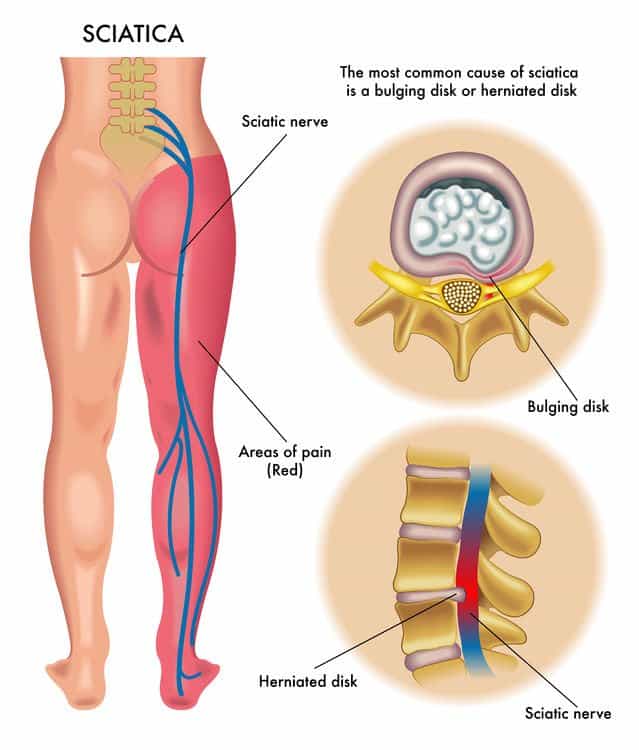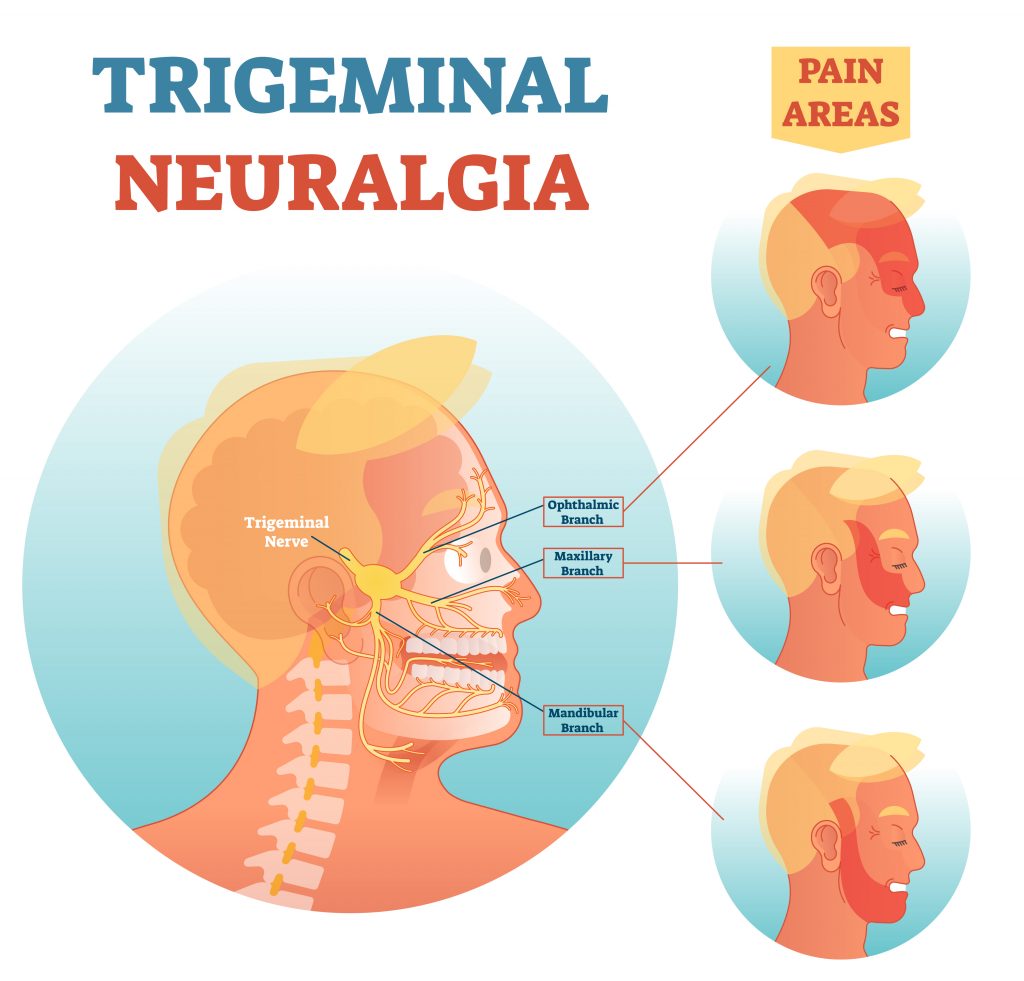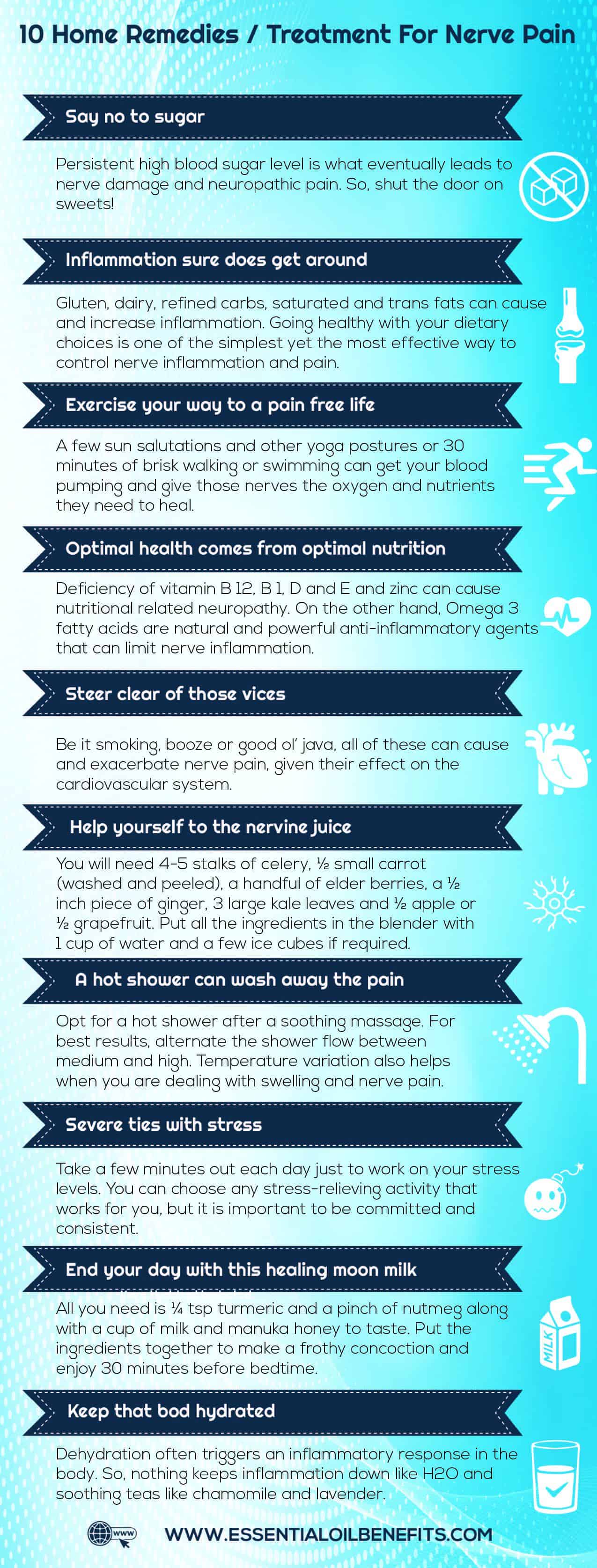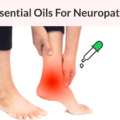Nerve discomfort can be a sign of several different conditions, including diabetes, shingles, HIV and cancer. For some, nerve pain is irritating; for others, it is demoralizing and life changing. No matter how it feels, nerve pain can disrupt every aspect of your life.
Research shows that people with nerve pain are more likely to experience problems like disturbed sleep, stress, anxiety and depression. On top of that, when you have a major medical condition such as cancer or HIV, dealing with the extra anguish of nerve pain can be an almost impossible thing to do.
While nerve pain cannot be eradicated completely, it can be minimized to an extent that it stops affecting your life – and there are numerous excellent natural options available to do so.
While it is very important to address the root cause of the pain, using essential oils can do a good job at alleviating the discomfort experienced in most cases of nerve pain. Just like any other natural remedy, it might take a little trial and error and/or tweaking to figure out the best essential oil mix for a person, however it is well worth it.
When figuring out which essential oils to use for your condition, consider what the condition triggering the pain is, what the intensity of the pain is, as well as the psychological element involved.
What Is Nerve Pain?
Although there are 3 types of nerves, neuropathic pain is only caused by sensory nerves. It can be the result of nerve damage, inflammation or lesions in the nerve path that can occur due to an injury, infection or a chronic ailment. The damaged nerves misfire and send pain impulses to the brain even when there isn’t an actual painful stimulus involved.
To add to the problem, neuropathic discomfort is often chronic and intensifies over a period of time. In fact, so profound is the impact of the pain on the life and the emotional wellbeing of the patient that antidepressants are often recommended to control the psychological ramifications of the discomfort.
What Causes Nerve Pain?
There are various causes of nerve pain, including the following:
1. Trauma
This is the most obvious cause of nerve damage and subsequent pain. Injury to the nerve or compression due to swelling of the muscle/bone fracture or a nerve getting severed due to a deep cut can all lead to neuropathic pain.
2. Degeneration
Repetitive movements can cause nerve damage and lead to pain.
3. Diabetes
Almost 70% diabetics suffer from neuropathic pain due to the nerve damage caused by high glucose levels.
4. HIV
Nearly 40% HIV patients suffer from never pain in the hands and the feet. The infection as well as the drugs used to control it are both known to cause neuropathic damage.
5. Infectious diseases
Not just HIV but also other viral and bacterial infections can lead to nerve pain. Most common among these are ailments like shingles, herpes, Lyme disease and hepatitis C.
6. Nutritional problems
Deficiency of B-12 and excessive amounts of B-6 are both known to cause nerve damage and pain.
7. Cancer
Tumors can lead to nerve compression while chemotherapy and radiation therapy can cause nerve damage.
8. Autoimmune disorders
Systemic autoimmune diseases as well as those that specifically target the nerves and the nervous system can cause nerve pain. The autoimmune conditions that can lead to neuropathic discomfort include lupus, Sjögren’s syndrome, rheumatoid arthritis, chronic inflammatory demyelinating polyneuropathy, Guillain-Barré syndrome and multifocal motor neuropathy.
9. Cardiovascular problems
Narrowing of the arteries and circulatory issues can damage the nerves and cause pain.
10. Liver and kidney issues
The accumulation of toxins in the blood caused by liver and/or kidney problems can cause irreversible damage to the nerves.
11. Hormonal imbalance
Because fluctuations in hormone levels have a direct impact on metabolic activity, they can lead to muscle swelling. In turn, this can compress and damage the nerves.
12. Toxicity
Heavy metal toxicity involving arsenic, lead and mercury also causes nerve damage.
Symptoms Of Nerve Pain
Neuropathic pain can affect a particular part of the body or run along the nerve path. It feels different from muscular and bone discomfort. For instance, the symptoms can be as follows:
- The pain can be felt as a stabbing, burning or shooting sensation.
- It may start at a particular point but will quickly radiate to other parts.
- Often, it feels like a jolt of electricity and is sudden and sharp.
- Nerve damage can cause extreme sensitivity even to stimuli which is not normally painful.
- You may feel pain when brushing or touching the skin or when fabric comes in contact with your skin.
- Pain caused by nerve damage can slow down reflexes.
- Periods of rest don’t always work to alleviate the discomfort.
- Neuropathic pain usually worsens with age.
- The discomfort also tends to intensify at night.
- The pain can be accompanied by other symptoms of nerve damage such as tingling, pricking and numbness.
4 Reasons Why Essential Oils Are Good For Nerve Pain?
1. They help with the pain…
Essential oils that offer warming and cooling effects are in essence counterirritants that help to deplete the chemicals involved in the transmission of pain impulses. So, these natural ingredients offer almost immediate relief from pain, which is often the number one priority when dealing with the shooting/stabbing discomfort that is nerve pain.
2. They work on the inflammation…
These aromatic extracts are also extremely potent anti-inflammatory agents that strike at the very root of the problem by suppressing the immunological response that triggers inflammation.
3. They get rid of infections that cause trouble…
Unlike the offerings of modern medicine, essential oils can eliminate all types of pathogenic critters. Because they help to ward off infections, they also limit the damage that these germs cause, which means that essential oils work on two fronts to control and treat inflammation.
4. They limit the psychological impact of pain…
Chronic pain is a known cause of anxiety and depression. Also, if you are in pain, sleep will, no doubt, elude you. But not if you rely on essential oils!
By night you can use the sedative properties of these oils to lull yourself to sleep, and by day, you can rally the energizing aromas of the oils to chase away fatigue. The best part is that you get both of these benefits without any side effects.
What Are The Best Essential Oils To Use For Nerve Pain?
Whilst every essential oil has beneficial properties of its own, the effectiveness of some oils in dealing with nerve pain like pinched nerves is more than others. In my humble experience, some oils work well for nerve discomfort, while others are more suited to dealing with muscle or joint conditions. When dealing with nerve pain, the lamiaceae family are a reliable source to consider.
Recommended Natural Product For Nerve Pain
My FDA-approved blend of essential oil for pain relief, L’orpur contains 8 essential oils and 2 carrier oils in a proprietary blend. L’orpur pain relief blend is very effective for all types of pain including nerve pain. Don’t wait any longer if you are after immediate relief!
14 Essential Oils To Get Rid Of Nerve Pain
1. Eucalyptus
The analgesic effects of this oil are just as well-known as its camphorous aroma. Yet, few know that the cooling sensation offered by this aromatic extract works not just on sore muscles but also on frayed nerves, and quite literally so.
The ability of this oil to control heightened neuropathic sensitivity comes courtesy of 1, 8 cineole (eucalyptol), which gives this ingredient its familiar cooling effect. This bioactive is also responsible for the antispasmodic and the anti-inflammatory properties of eucalyptus oil and its distinctive aroma.
2. Chamomile
Of the two chamomiles, Roman has always enjoyed star status owing to its content of chamazulene, while German has been somewhat of a side kick. But when it comes to nerve pain, German chamomile has the super hero traits you need, and these are attributed to its high content of alpha-bisabolol.
This bioactive compound decreases the excitability of the peripheral nerves, thus lowering the intensity of neuropathic pain. As far as azulene is concerned, this phytochemical has an extraordinary ability to control inflammation and it has a sedating effect on the nervous system. So if possible, use a combination of the two chamomiles, but if that cannot be done, opt for German over Roman chamomile.
3. Thyme
The inclusion of this oil is attributed to its thymol content. Another monoterpene with analgesic effects, thymol can actually disrupt the transmission of pain impulses through the nerve network and the spinal cord. Additionally, it controls the inflammatory reaction of the body in response to both oxidative stress and physical injury.
4. Clove
Everybody knows about the analgesic properties of this oil, but most associate it only with tooth pain. Actually, the reason why clove oil works so well on tooth ache is because its active ingredients are exceptionally effective at tackling nerve irritation, inflammation and infection. And that my friends is the reason to include this oil in any blend meant to control nerve pain.
5. Balsam Fir
This is one of those rare oils that was used by medical practitioners from almost all ancient cultures. So it comes as no surprise that present day aromatherapists and holistic practitioners continue to rely on this oil for its ability to heal both the mind and the body.
The combined sweet and pungent woody notes of balsam fir give you many of the mental benefits of forest bathing. And if that is not enough, the bioactives in this oil, like beta-phellandrene, bornyl acetate and both isomers of pinene, help to tackle neuropathic hypersensitivity as well as muscular inflammation, swelling and pain.
6. Frankincense
Another classic choice, this resin derived oil has been used for centuries to control inflammation and the pain and stress that it brings along. Frankincense oil also has noteworthy antimicrobial properties, which are attributed to its very high content of alpha-thujene.
The best part of using this oil is that it’s tough on pain and inflammation but gentle on the skin. So, it can actually take away from the irritating effects of the some of the other oils in the mix.
7. Wintergreen
This oil can be found any many OTC pain formulations all thanks to its content of methyl salicylate or natural aspirin. If you have ever used a liniment or spray for muscular pain, you must have already experienced its analgesic properties. But this one should be reserved for when the pain is too much to bear because aspirin, in any form and regardless of its source, is known to stress the liver.
The anti-spasmodic, analgesic, anti-inflammatory and soothing abilities of Wintergreen also help in conditions like muscle knots and spasms, gout, arthritis, joint and muscle pain and nerve swelling.
8. Geranium
The light and breezy floral fragrance feels like the gentle fluid warmth of the spring sun and appeals to almost everybody. But the “happiness inducing” effect of this oil is just one of its several benefits.
Along with the pleasing aroma, you also get boat loads of citronellol and geraniol, which are the main constituents of this oil. These phytochemicals are proven to be effective against neuropathic pain that results from inflammation and the hyper-excitability of the peripheral nerves.
9. Ginger
Long used for nerve pain in Ayurveda, ginger essential oil is a potent peripheral anaesthetic that not only relieves discomfort but also acts as a neuroprotective agent. This aromatic extract is particularly effective when used against nerve pain that results from lesions in the nerve pathway. The warming effect of the oil calms irritated nerves and soothes swollen muscle tissue, while lowering the inflammatory response of the body.
10. Sweet Basil
Although many “spice” and “herb” oils offer pain relieving effects, this is one of the few aromatic extracts that was found to be effective against trigeminal neuralgia. Moreover, the p-cymene in this oil not only helps to reduce inflammation but also controls factors that trigger the body’s inflammatory response.
11. Helichrysum
The only reason this oil does not get the mainstream attention it deserves is because of its steep price tag. Normally, I suggest a substitute but if you are dealing with nerve pain, helichrysum oil is truly the best and most effective.
In fact, I’d go so far as to say that the unique combination of bioactive compounds in this oil makes it worth every cent you pay for it.
12. Lavender
There is a reason this oil finds a place in the essential oil kits of professionals, DIYers and newbies alike. Its pleasing aroma helps to chase away the mental trauma of chronic pain while its active constituents offer antispasmodic, anti-inflammatory and analgesic effects. Plus, there are scores of studies that back the efficacy of this oil when used to treat peripheral neuropathy.
13. Sweet Marjoram
With its soothing warmth and pungent-herbaceous odor, this oil is a popular choice for pain relief, whether the discomfort involves muscle fatigue or nerve irritation.
A powerful healing agent, sweet marjoram oil does more than just control the pain and inflammation. It actually helps to heal nerve damage, and any strides in this direction can go a long way in alleviating neuropathic pain.
14. Peppermint
The icy cool effect of this oil offers almost immediate relief from pain, while its herbaceous and minty fresh odor chases away fatigue and anxiety. But, the list of the benefits of peppermint essential oil runs quite long.
The anti-inflammatory and antispasmodic oil is one of the richest sources of menthol, which acts as a counterirritant and blocks the excitation of the nerves in response to inflammation and injury. Moreover, this oil regulates the body’s endogenous/natural pain relief mechanism. Put all of those benefits together and you get a complete pain relief solution in just one oil.
So, here we come to the end of the list of essential oils that are useful for treating nerve conditions. As mentioned before, which oils you end up contributing to your blend will depend upon who the mix is for and what the cause and extent of the pain is.
How To Use Essential Oils For Nerve Pain?
1. For sciatic nerve pain
It is estimated that at least 40% of all people will experience sciatica nerve pain at least once in their life. Sciatica is not a condition but the symptom of sciatica nerve irritation. In the majority of cases, the irritation is caused by an injury that results in a herniated disc. However, disc degeneration due to repetitive movements can also lead to sciatica.
Because it is the largest nerve in the human body that starts in the lower back and runs through the buttocks and along the length of both legs, any problems with this nerve can have serious health ramifications.
Sciatica nerve pain is often intense to the point of being debilitating. It can be mild in the beginning, but the discomfort intensifies as the irritation increases and leads to greater inflammation of the nerve. It is a radiating pain that starts in the lower back area and shoots down one/both legs.
Because this nerve controls the movement of the lower limbs, sciatica also causes weakness in the legs and impacts your ability to move about. Surgery is the only treatment option available, but it’s rarely recommended because the risks generally outweigh the benefits.
The alternative to surgery is the consistent use of pain killers and antidepressants, and we all know that these drugs have serious side effects. So, stay away from those pain pills and use this essential oil blend instead. You will need:
Recipe 1: massage blend
- 60 ml light carrier oil
- 8 drops each of lavender and frankincense
- 5 drops clove
- 7 drops peppermint
- 4 drops wintergreen (optional only if pain is intense. Make a separate blend containing wintergreen, which should only be used occasionally)
Method
Mix the oils together and store in a dark glass bottle. Massage on the sore areas, moving your hands down and away from the spine, along the nerve path. Use gentle downward strokes without exerting a lot of pressure on the nerve. The last thing you want to do is to irritate the nerve further. Follow with the recipe below.
Recipe 2: hot compress
- 2 cups of sea salt/Himalayan pink salt
- 10 drops each of turmeric and ginger
- 1 tsp carrier oil
- An old pillow case
- A string to tie the pillow case and make a salt pack
Method
Mix the oils in a small bowl and set aside. Pour the salt into the pillow case and microwave for 30-40 seconds. Check for heat before taking it out. Add the oil mixture to the salt and mix using a spoon. Don’t spend a lot of time on this as you don’t want the salt to cool.
Just a quick stir and then tie the mouth of the pillow case with a string to make a salt pack. Use as you would a heat pack. I would suggest that you don’t place it directly on your skin at first. Instead, cover your skin with a thin bed sheet for a few minutes and once the heat dissipates a bit, go for direct skin contact. Use this treatment combination 1-2 times a day for best results. If you intend to use the heat pack again on the same day, add half the quantity of oils for round two.
2. For neuralgia
Postherptic neuralgia, which results from shingles related skin and nerve damage, causes burning pain at the site of the blisters even after they subside. Patients describe the discomfort as a burning coal kept on the skin.
But, even that is no match to the intensity of the pain caused by other forms of neuralgia, such as trigeminal, occipital and glossopharyngeal. All of these cause pain in areas above the chest, such as the head, the face, the neck, the jaws and behind the eyes.
Although the pain is short lived and intermittent, its intensity has driven many into depression and even suicide. Neuralgia is simply another term used for nerve pain but in this case, the pain is far more intense and not always the result of damage, inflammation or lesion.
For instance, trigeminal neuralgia is often caused by a major blood vessel that compresses the nerve leading to irritation. Often, there is no precise cause for the pain and nerve irritation. But the pain is excruciating, nonetheless. So, if you are suffering from neuralgia, here is a soothing and calming blend that will help. To make it, you will need:
- 40 ml St John’s wort infused oil (available online or you can make your own by infusing the herb in sesame seed or virgin olive oil).
- 10 drops each of palma rosa and geranium
- 5 drops each of copaiba and sweet basil
- 8 drops peppermint (optional for postherptic neuralgia or when the pain is felt as a burning sensation) (increase carrier oil quantity to 50 ml if adding peppermint)
Method
Mix the oils and store them in a dark glass bottle. You can use the blend to treat the pain as and when required (opt for the peppermint oil included recipe) or as a preventative measure 1-2 times a day. Neuralgia pain is felt along the nerve path, so use a Q tip dipped in the blend to apply along the length of the nerve.
Do a patch test before use because you will be applying it to your face and neck. The blend can also be used on the forehead and on the temples. You don’t have to normally wipe/wash the blend away, after use.
If you want to apply another product, cosmetic or other, simply wipe treated area gently with some warm water. It is recommended that you allow the blend to act on the nerve for at least 3-4 hours before wiping/washing it off.
3. For numbness and tingling
There is a name for that skin crawling feeling that you experience when you sit with your legs crossed for too long or sleep with one arm under your body. It’s called paresthesia, and while it isn’t painful, it sure does get your attention.
It is caused when the blood flow or nerve impulse flow from a particular body part is blocked for some reason. Imagine a traffic bottleneck of sorts to the point where all cars come to a standstill. That is pretty much what happens when the nerve impulse/ blood flow get blocked due to compression force or because of any factor that impacts the circulatory or nervous system.
The block is what causes the numbness and once it is released, the impulses start flowing at twice the speed, leading to hyper sensitivity, and that is felt as prickling and tingling. While most of us only have to put up with this annoying sensation occasionally for those who suffer from diabetes and other health ailments that cause nerve damage and inflammation, paresthesia is a common and almost daily occurrence. Whatever your history with the skin crawling sensation, use this blend to send it packing out of your life. You will need:
- 30 ml carrier oil [preferably ashwagandha (Indian ginseng) infused oil. This can be bought online
- 6 drops each of sweet marjoram and eucalyptus
- 4 drops ginger
- 5 drops rose geranium
Method
Preparation and storage as above. Use this oil to treat and not prevent paresthesia. Apply with a few minutes of vigorous rubbing for best results. If you suffer from diabetes, this blend can help to improve circulation in the extremities but don’t use on open wounds/sores. However, you can use this blend once scabs have formed. Combine with gentle stretching or a few rounds of pacing for fast relief.
4. For nerve pain after surgery
Nerve pain after surgery can result from a myriad of factors and can last for several months or even years after the procedure. There is no surefire way to know if a person will suffer from post-operative neuropathic pain. However, a study have pointed to a possible connection between the intensity of the acute pain experienced after surgery and the likelihood of suffering from chronic neuropathy after the procedure.
What is normal after surgery: Of course you will feel some amount of pain immediately after the surgery. But you can be sure that at least for the first 1-3 days after the procedure, you will be kept on heavy-duty painkillers.
You will be weaned off them gradually, which means that by the 4th or the 5th day, the pain should be bearable and only felt when the wound is touched. If you are experiencing intermittent bouts of intense, shooting pain, you need to talk to your doctor about it. If post-surgery infection is ruled out, chances are that a nerve in the area of the incision is the trouble maker.
Existing neuropathy can cause a problem: The risk factor is understandably high if you have a history of nerve pain or if the surgery is meant to deal with accident related injuries that have impacted a nerve/nerves. Similarly, post-operative complications such as infections can increase the healing time and the body’s immunological response, thus increasing the risk of nerve pain after surgery.
Inflammation causes all the trouble: Usually, post-surgical nerve pain is caused when a nerve gets severed, damaged, entrapped or compressed during the procedure or as the incision heals. There is also mounting evidence that nerve inflammation leads to chronic pain after surgery, even when the nerves are not damaged/entrapped in any way.
Is it post-surgical neuropathy: Nerve pain that results from surgery is always localized at and around the incision site. It is intense and intermittent and felt as a burning or stabbing discomfort.
If you are suffering from post-operative neuropathic pain, here is a blend that can offer significant relief from the discomfort and help in healing the inflamed and irritated nerves. You will need:
- 60 ml Jojoba oil
- 10 drops helichrysum oil
- 3 drops each of rosemary and thyme
- 5 drops each of turmeric and rose geranium
- 7 drops peppermint
Method
Mix the oils and store in a dark colored glass bottle away from sources of light and heat. Use on the incision site after the wound has healed completely and around the incision if it needs more time to heal. Apply as you would any antiseptic ointment, using gentle strokes towards the lymph nodes in the area. You do not have to wash the ointment off.
If you are allowed to shower, a mild soap and some warm water will be enough to keep the affected area clean and prepare it for the next round of treatment. If the wound has not healed enough for you to take a bath, wipe the area of application once a day with some warm chamomile tea. Use twice a day for up to 3 weeks then take a break of one week.
5. For nerve pain from chemo
One of the lasting yet oft ignored side effects of chemotherapy is nerve pain. Since it is not a life threatening condition, it rarely gets the attention it deserves. The pain does not cause physical harm, but it does impact mental health and adds to the fatigue and anxiety that are inherent to both the condition and its treatment.
The extremities are usually the first to be affected by chemo induced neuropathic pain (CINP) and patients start experiencing numbness, tingling, burning and pricking pain as soon as the treatment is started. Unfortunately, there is no telling for how long the pain will last.
In some patients, the discomfort is only experienced for a few weeks after the treatment is stopped/completed. However, there are cases in which the nerve pain turns into a chronic issue. Depending on the intensity of the pain and the patient’s condition, everything from OTC painkillers to opioids and from anticonvulsants to antidepressants can be used to tackle the problem.
Alternative therapies are also known to help and are recommended in this rare instance. In fact, a capsaicin (hot chili pepper oil) patch with lidocaine has shown much promise in alleviating CINP. This proves that inflamed and irritated nerves do react positively to warming oils. Hence, here are two blends that combine the anti-inflammatory, anxiolytic, anti-depressive and the heating and cooling effects of EOs for best results. You will need:
For the day blend:
- 60 ml carrier oil
- 10 ml evening primrose oil
- 5 drops each of turmeric, frankincense, geranium and lemon
- 7 drops each of ginger and peppermint
For the night blend:
- 40 ml ashwagandha infused oil (Indian ginseng/ mustard seed carrier oil, not essential oil)
- 4 drops black pepper
- 5 drops eucalyptus
- 7 drops each of sandalwood and lavender
- 4 drops coriander
Method
Mix the oils and store in dark colored glass bottles. Use as you would any massage oil but only on the affected parts. Do not use each blend more than 1-2 times a day and consult with your doctor before using these blends.
6. For nerve pain in back
Most cases of back pain are benign and caused due to physical stress, but this is no reason to rule out nerve inflammation. Let us not forget that your back hosts the spinal cord, so there sure are a lot of nerve roots in this area. Add to this the fact that your back endures a significant amount of stress, regardless of your physical activity levels and it is easy to see why your back pain may find its roots in a nerve root.
Although sciatica is by far the most common cause of nerve pain in the back, a pinched nerve due to an injury can just as well cause neuropathic pain in the middle or upper back. Similarly, incorrect posture, a herniated disc, repetitive movement and spinal arthritis can also lead to nerve compression or damage and end up causing pain.
As with other forms of neuropathy, back pain that is related to nerve inflammation or irritation will have a distinct radiating quality to it. Furthermore, rest may/may not help in easing the discomfort. Compare this with muscular pain, which is often experienced as a deep and throbbing discomfort. That said, neuropathic pain can also lead to other tell-tale symptoms such as tingling and numbness.
Fortunately, surgery is only required in 5-10% cases of nerve related back pain as in most patients, physical therapy, massage and topical pain relief products are enough to treat the discomfort. So, here are two EO blends for nerve pain in the back that can be used with any other form of alternative therapy as well as conventional treatment options. You will need:
For the massage oil:
- 60 ml St John’s wort infused carrier oil
- 7 drops each of balsam fir, eucalyptus and ginger
- 5 drops neroli
- 9 drops German chamomile
Method
Preparation and storage as above. Rub the oil on the sore areas of the back and massage with your fingertips, moving your hands away from and outward from the center of the back. Also move up and down the length of the spine but remember to not rub/ press/put pressure directly on the spine. The bony structure houses the spinal cord, so you don’t want to fool around with it.
The best way to give a back rub is to work on the fleshy area on both sides of the spine. Using your fingers and thumb pad limits the amount of downward pressure that you exert. Apply the oil as soon as you feel the pain/numbness/tingling. Follow with a hot bath.
For the bath:
- 1 cup sea salt/Himalayan pink salt
- 1 tbsp milk (dairy or plant)
- 2 drops each of rose geranium and palma rosa
- 1 drop peppermint
Method
Fill the bath tub with hot water (hot enough for a 15-20 minute soak) and add salt to it. Mix the essential oils with milk and pour the blend into the tub. Agitate the water and soak your back in its soothing goodness for 15-20 minutes. Combine the two treatment options at the end of the day for best results.
7. For nerve pain in neck
The machinery is complex and handles a lot of work and weight, if that is not a recipe for trouble, I don’t know what is. Well folks, that is your neck for you! The technical term for nerve pain in the neck is cervical radiculopathy and more often than not it results from a disc related issue.
Initially, you may experience throbbing pain in the neck, but as the damage and inflammation build, it takes on all the classic traits of neuropathy. For one, nerve pain in the neck will always radiate to the shoulders and even to one or both arms. It will also creep up into the area that joins the neck to the head and will feel like tingling and numbness in this part.
You may also experience prickly pain in the fingers, and your grip may weaken over time along with your ability to interpret sensory inputs. If you have any of these symptoms along with persistent or worsening neck pain, see your doctor about it. Cervical radiculopathy can be a symptom of Cauda equina syndrome, which is a medical emergency.
Like with nerve related back pain, the risks of surgical interventions far outweigh the benefits, which is why you will seldom be asked to go under the knife. So, your best bet is to work with alternative therapies. Yoga, physical therapy, posture improvement exercises and acupuncture can all help immensely. But you are bound to experience pain along the way and this is where essential oils can come to your rescue. This is what you will need:
- 60 ml carrier oils of your choice
- 7 drops each of copaiba and ginger
- 10 drops peppermint
- 9 drops each of lavender and German Chamomile
Method
Preparation and storage as above. This blend can be used to both prevent and treat neuropathic neck pain. For prevention, once a day application will be adequate and for treatment use no more than 2-3 times a day.
You will feel a combined warming and cooling effect within a few minutes of application. Use your finger tips to apply and gently rub into the skin. As stated above, do not put direct pressure on the spine. In fact, when working on the neck, you have to be very gentle.
The goal is to soothe the nerve roots and not to irritate them more. Also, apply the blend along the pain pathway that may go from the neck to the shoulders or the arm.
For best results, follow with a hot compress for pain and a cold compress if you have swelling and other signs of inflammation along with the pain.
10 Home Remedies / Treatment For Nerve Pain
1. Say no to sugar
If you want to prevent or treat diabetic neuropathy, you have to keep your blood sugar level in check, there is simply no way around this. Persistent high blood sugar level is what eventually leads to nerve damage and neuropathic pain. So, shut the door on sweets!
2. Inflammation sure does get around
An inflammatory response anywhere in the body causes imbalance and raises the risk of inflammation in other parts. So, try your best to keep inflammation out of your life by making smart dietary choices. Gluten, dairy, refined carbs, saturated and trans fats can cause and increase inflammation. Going healthy with your dietary choices is one of the simplest yet the most effective way to control nerve inflammation and pain.
3. Exercise your way to a pain free life
This may seem counterintuitive at first, but getting off that couch/bed/chair and moving about is one of the best ways to get those nerves to work as they should. A few sun salutations and other yoga postures or 30 minutes of brisk walking or swimming can get your blood pumping and give those nerves the oxygen and nutrients they need to heal.
4. Optimal health comes from optimal nutrition
Depending on your lifestyle and dietary choices, you may suffer from nutritional deficiencies even if you judiciously have your 5-8 servings of fruits and veggies. But, this is one area in which self-medication can have disastrous consequences.
So, before you gulp down a multivitamin talk to your doctor about it. The deficiency of vitamin B 12, B 1, D and E and zinc can cause nutritional related neuropathy. On the other hand, Omega 3 fatty acids are natural and powerful anti-inflammatory agents that can limit nerve inflammation.
5. Steer clear of those vices
Be it smoking, booze or good ol’ java, all of these can cause and exacerbate nerve pain, given their effect on the cardiovascular system.
6. Help yourself to the nervine juice
Put your blender to work and whip up this lip-smacking nervine juice. You will need 4-5 stalks of celery, ½ small carrot (washed and peeled), a handful of elder berries, a ½ inch piece of ginger, 3 large kale leaves and ½ apple or ½ grapefruit. Put all the ingredients in the blender with 1 cup of water and a few ice cubes if required.
7. A hot shower can wash away the pain
When you are seeking pain relief on the double, opt for a hot shower after a soothing massage. For best results, alternate the shower flow between medium and high. Temperature variation also helps when you are dealing with swelling and nerve pain. Simply alternate between hot and cold showers for about 15 minutes and you will not only dull the pain but will also walk out feeling invigorated.
8. Severe ties with stress
Chronic stress leads to excessive cortisol in the body. Even if you have an otherwise healthy lifestyle, this neurochemical can wreak havoc on every one of your physiological systems. So, take a few minutes out each day just to work on your stress levels. You can choose any stress-relieving activity that works for you, but it is important to be committed and consistent.
9. End your day with this healing moon milk
This one is easy to make and delicious. All you need is ¼ tsp turmeric and a pinch of nutmeg along with a cup of milk (dairy or plant; use nut instead of soy) and manuka honey to taste. Put the ingredients together to make a frothy concoction and enjoy 30 minutes before bedtime.
10. Keep that bod hydrated
Dehydration often triggers an inflammatory response in the body. So, nothing keeps inflammation down like H2O and soothing teas like chamomile and lavender.
The Bottom Line
Nerve disorders are highly uncomfortable to deal with. Consequently, more and more people are looking towards using essential oils to help themselves manage this agonizing condition. While being safe and effective for any kind of nerve disorder, essential oils have an instant effect on the brain. Several studies support their ability to affect the nervous system positively and facilitate the healing process.

















